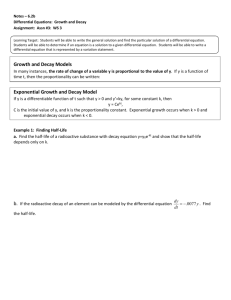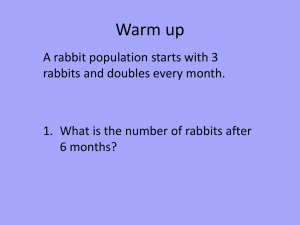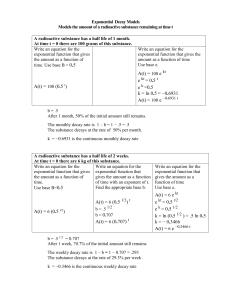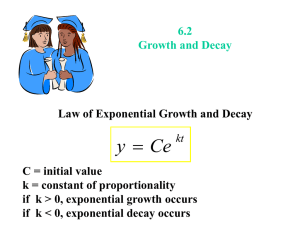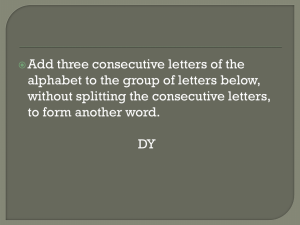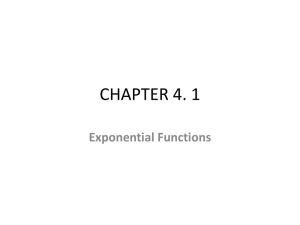Developing an Intuitive Grasp of Exponential Functions
advertisement
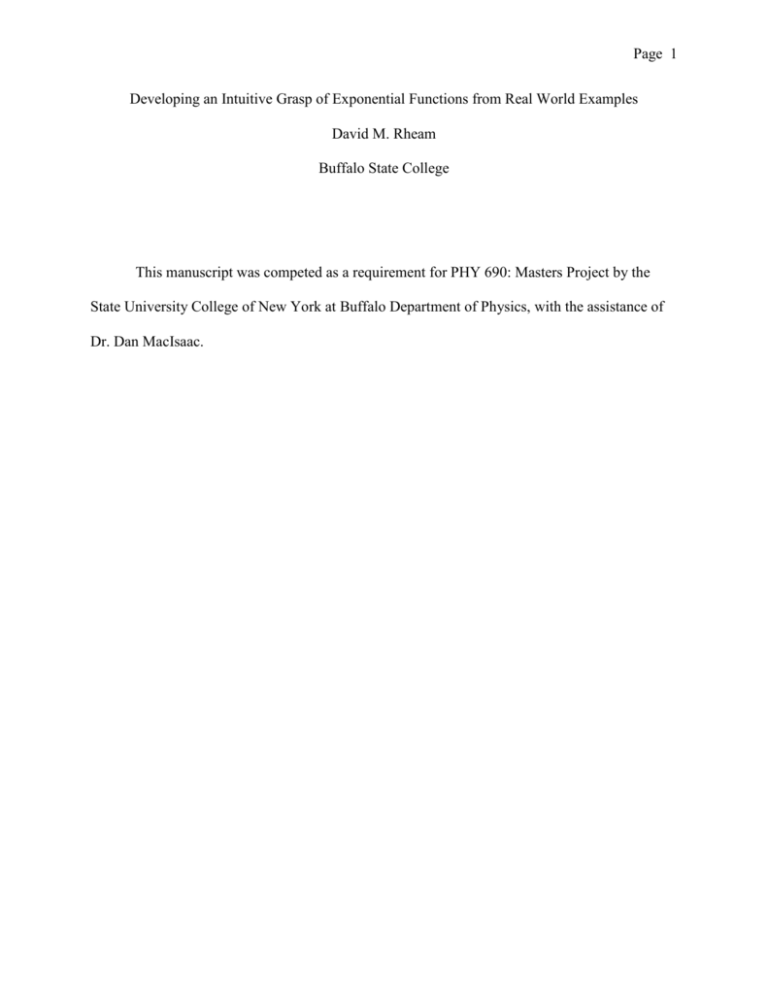
Page 1 Developing an Intuitive Grasp of Exponential Functions from Real World Examples David M. Rheam Buffalo State College This manuscript was competed as a requirement for PHY 690: Masters Project by the State University College of New York at Buffalo Department of Physics, with the assistance of Dr. Dan MacIsaac. Page 2 Abstract According to Albert A. Bartlett “The greatest shortcoming of the human race is our inability to understand the exponential function” (Bartlett, 1976, p.394). So it should not be surprising to us that many of our high school students have difficulty grasping concepts involving exponentials. Part of the reason for this is that students enter our classrooms with their own ideas about the way things grow and decay from what they have seen in their own life experiences. They see the way that they themselves develop, or that plants and animals around them grow, or they watch the way a candle shrinks as it burns and they formulate ideas about how growth and decay happens. Unfortunately, most of what they see is not exponential. It is extremely difficult to change these deep seeded beliefs that our students have and unless they have several encounters in our classrooms where they experience exponential growth for themselves they will return to their preconceived notions about these topics. In this manuscript, I will describe several possible classroom experiences that can help students discover exponential functions and then I will connect them to some important topics in the realm of physics. I will also give some practical examples of where students can see exponential growth in everyday life and how they can determine the significance of the growth or decay that they see. Page 3 Developing an Intuitive Grasp of Exponential Functions from Real World Examples Introduction According to Albert A. Bartlett (1976) “The greatest shortcoming of the human race is our inability to understand the exponential function” (p.394). So it should not be surprising to us that many of our high school students have difficulty grasping concepts involving exponentials. Part of the reason for this is that students enter our classrooms with their own ideas about the way things grow and decay from what they have seen in their own life experiences. They see the way that they themselves develop, or that plants and animals around them grow, or they watch the way a candle shrinks as it burns and they formulate ideas about how growth and decay happens. Unfortunately most of what they see is not exponential growth and decay but linear. The concept of linear growth is then reinforced as students study it in our mathematics curricula as a central theme in algebra. “First year algebra students spend a significant amount of time studying linear functions. A typical unit involves evaluating linear functions, graphing linear functions by several methods, and application of linear functions that involved linear growth. Students with a good understanding of slope as a constant rate of change are not at all surprised with the results of linear relationships.” (http://64.233.169.104/search?q=cache:Gij1C211EEoJ:www.mste.uiuc.edu/courses/ci300 su01/telahart/rprojectfor301revisedthurslahart3.doc+teacher%27s+guide+linear+growth+ vs.+exponential+growth&hl=en&ct=clnk&cd=1&gl=us) So students have countless real life experiences as well as several classroom experiences that all point to the same type of growth and because of this many students think that all growth is linear growth. Page 4 It is extremely difficult to change these deep seeded beliefs that our students have. They cannot simply be taught a formula or shown a graph dealing with exponential growth and decay and be expected to understand how it works. The only way for students to truly grasp the idea of this new kind of growth is for them to have the same type of interaction with exponential growth as they had with linear growth. This requires that we give them new, real life experiences in our classroom where they can encounter and discover exponential growth for themselves. If this is not accomplished many students will return to their preconceived notions about growth. In this manuscript, I will describe several possible classroom experiences that can help students discover exponential functions and then I will connect them to some important topics in the realm of physics. I will also give some practical examples of where students can see exponential growth in everyday life and how they can determine the significance of the growth or decay that they see. Exponential Growth When first introducing to the topic of exponential growth “I say keep it simple! Use only as much mathematics as is needed” (Goldberg & Shuman, 1984, p.344). In order to do this it is important to “restrict you arithmetic to the familiar four: multiplication, division, addition, and subtraction” (Goldberg & Shuman, 1984, p.344). “The story of the exponential function can best be told as the story of powers of two” (Bartlett, 1976, p.398), or in other words, one of this simplest ways to think of exponential growth is something that has a constant doubling period. A good introduction to this concept of a doubling period and the power of exponentials is to do a lesson that acts out a story about a king and a chessboard. “According to the legend, the game of chess was invented by the Brahmin Sissa to amuse and teach his king. Asked by the grateful monarch what he wanted in return, the wise Page 5 man requested that the king place one grain of rice in the first square of the chessboard, two in the second, four in the third, and so on, doubling the amount of rice up to the 64th square” (http://www.cs.berkeley.edu/~vazirani/algorithms/chap8.pdf). After introducing this story to students, or a more detailed version in the book “The King’s Chessboard” by David Birch, ask students what they think about the strange request, without giving them any feedback on their answers. Then have them start to act out the man’s request in groups of 3 or 4. Because the numbers get so large so fast I would recommend shrinking the chessboard to a four by four grid written on a large sheet or shower curtain with each square being approximately 1 square foot, and giving each group of students about a quartsize bag with a little over 1 pound of rice in each bag. The larger squares allow the students to actually put all the rice on the squares and the smaller grid will give students the idea of what is happening with out having to deal with astronomical numbers right in the beginning. To save students time and the tediousness of always counting out individual grains of rice it’s helpful to give them some measuring spoons and some key measurements, like 1 Teaspoon is equal to 256 grains of rice (more measurements can be found in Lesson Plan 1). It is also important to have at least one student in each group recording the data in a spreadsheet (using a program like Microsoft Excel if possible). This spreadsheet should include columns for the square number, the number of grains of rice (it may be useful for them to write this out with multiplication or as powers of two), and the total rice so far. If it is possible, having students come up with some or all of these categories themselves in the discussion after the story is ideal. When the students get to the last square on their grid they should run out of rice because the last square in the 4 x 4 grid should have 32,768 grains of rice on it, which is approximately 1 pound of rice (it may be helpful to have a 1 pound bag of rice to give the students a visual Page 6 example of how much rice it is). Since their data is already recorded in a spreadsheet it should be quick and easy for the students to graph the results that they have and see a graphical representation of what has been happening with the rice. Once the students have reached this point it is beneficial to have them reflect back on what they have just done by thinking through some key questions such as: Compare the number of grains of rice on the 16th square to how much rice had been used on the previous 15 squares? When did you know you were going to run out of rice? What do you think would happen if your graph continued? How much rice would be used on the 32nd square? How about the last square? So, through one activity, students have gained knowledge about exponential growth in a variety of ways. They have experienced it through counting the rice grains and putting them on the grid, they have written it algebraically with the numbers on the spreadsheet, and they have seen it in a graphical representation. Another example of where students can see the power of multiplying by two can be from simply folding a piece of paper in half (Bartlett, 1976, p.394). One advantage of this activity is that it is so quick you can even be use it as a warm up activity. As students enter your classroom hand each of them a sheet of paper and challenge them to try and fold the piece of paper in half as many times as they can. Most students will be able to fold a standard sheet of paper 6 times (http://jzimba.blogspot.com/2007/05/understanding-exponential-growth.html) It is important to draw out from the students that this means the thickness of the paper will experience 6 doublings. When asked why the students couldn’t fold the paper anymore most students will say that the paper needs to be bigger. To make things more interesting you could even do a class experiment in the hall like this teacher did. Page 7 “Then we went out in the hallway and tried another folding experiment, this time folding a very long sheet of paper towels, over a hundred feet long. (We only used lengthwise folds in this case). As it turned out, the difference between a single sheet of paper and a hundred-footlong strip was only a single fold! Seven, instead of six” (http://jzimba.blogspot.com/2007/05/understanding-exponential-growth.html). There are several important facets of exponential growth that can be brought out through this activity. One is the suddenness of exponential growth. “After the first two or three folds, everything seemed to be going fine. Then, suddenly, when we went from fold #5 to fold #6, the game was suddenly up.” This is an amazing aspect of exponential growth that is never seen in linear growth. One of the questions after the grains of rice activity that is important to as is “When did you notice you were going to run out of rice?” Most students don’t realize this until they’re on last or next to last square. Albert Bartlett discusses a few interesting examples of this sudden growth dealing with bacteria in a bottle and algae on a lake in his famous talk on exponential growth which can be seen on www.youtube.com by searching “The Most Important Video You Will Ever See.” A second aspect is how astronomical the numbers would get if you were able to keep on folding the paper. At 7 folds the paper would be about the thickness of a notebook, by 10 folds it would be about the width of your hand (including your thumb) (http://raju.varghese.org/articles/powers2.html). The world record for folding a piece of paper is 12 times. This was thought to be impossible before it was done by a high school student named Britney Gallivan in January 2002 who was challenged to do it as an extra credit assignment in math class (www.pomonahistorical.org/12times.htm). This is actually referenced in the prime time CBS show Numb3rs (Season 1, Episode 8) where it is related to embezzlement and pyramid Page 8 schemes, which is another example of exponential growth. If you were able to continue folding by 17 folds it would be as tall as a two story house, by 20 folds it would be a quarter of the Sears tower, by 30 folds it would be past the outer limits of the atmosphere, by 50 folds it would reach all the way to the sun, by 70 folds it would be 11 light years long, by 80 folds it would be 12,000 light years long, by 90 folds is would be 12 million light years long, and by 100 folds it would be 12 billion light years long, which is approximately the radius of the known universe (http://raju.varghese.org/articles/powers2.html). Both the grains of rice activity and the folding paper both deal with things that double each time the event occurs. One area of physics where a similar type of doubling occurs is in a process called nuclear fission. Nuclear fission is the splitting of the nucleus of an atom into parts (lighter nuclei) often producing free neutrons and other smaller nuclei, which may eventually produce photons (in the form of gamma rays) (http://en.wikipedia.org/wiki/Nuclear_fission). In the nuclear fission of Uranium-235 the nucleus of the uranium is bombarded with a neutron. This neutron splits the uranium into smaller elements such as barium and krypton and releases heat and gamma particles. “The chain reaction occurs when "spare" neutrons from this atom fly out with sufficient force to split other U-235 atoms they come in contact with. In theory, it is necessary to split only one U-235 atom, which will release neutrons which will split other atoms, which will release neutrons, and so on” (http://inventors.about.com/od/nstartinventions/a/Nuclear_Fission.htm). “As these next nuclei undergo fission they release additional free neutrons which cause more fissioning. This ongoing process is known as chain reaction” (http://www.utc.edu/Research/AsiaProgram/teaching/index.php?section=4&part=1). This chain reaction of atoms splitting is a great example of exponential growth. However, it is important to Page 9 note that this is not a perfect example of doubling because sometimes the atom can split into 3 main parts rather than two and sometimes neutrons are lost in the process. Exponential Decay When moving into the topic of exponential decay it is important to approach it in a similar manner as to what we did for exponential growth. Just as exponential growth is something that has a constant doubling period, exponential decay is something that has a constant halving period. One way to illustrate this is to look at a bracket of NCAA basketball tournament and show students that in each round half of the teams get eliminated; this means that each round would be a half-life. Once the idea that the time it takes for something to be cut in half is a half-life, which most students grasp fairly quickly, there are several activities that you can do to help students experience this. Again most students will revert back to linear decay rather than exponential decay if they don’t experience it for themselves. One way to give them this experience in the classroom that leads smoothly into the topic of radioactive decay or discharging of a capacitor is to do a simple activity with dice. Have students break up into groups of about 3 or 4 students and give each group 64 dice (this number can obviously vary) and a container with a lid to shake up the dice in (that is big enough for all the dice to be spread out). Have the students shake the container and then take out all of the dice that have odd numbers and count the dice that are left. In this example each time you open the container and count the dice left should work out to be 1 half-life. Have students repeat this process until all the dice have decayed or until they have repeated the process 10 times. Then have students graph their results using Microsoft Excel (the number of rolls should be on the xaxis and the dice left should be on the y-axis). You can also demonstrate this curve for your class afterwards Page 10 “with two strips of paper, some glue, and a larger sheet of construction paper. To show the curve, simply paste one of the longer strips on the construction paper. The other strip should be cut in half and past one of the halves on the construction paper. The other half is cut in half again with one pasted to the paper. This is repeated until there is no paper left” (Palcic, 2006). There are several variations of this activity using coins or M&M’s, although M&M’s tend to get eaten which can be unsanitary. One advantage of using dice is that after the students have gone through this activity with having the odd numbers decay you can change up the activity and have different groups have different decays. For instance, one group may have only 3’s decay or another group may have 5’s and 6’s decay. This can makes things more challenging for the students because now each time they open the container doesn’t necessarily correlate to one halflife. Since students will be getting different results it can also lead into a time of discussion at the end of the period where each group shares what they have learned. One concept that is critical to bring out in this type of discussion is the fact that the number of dice that decay is proportional to the number of dice that were in the sample. In other words, as the number of total dice decreased so did the number of dice that decayed. One area of physics that deals with exponential decay is the discharging of capacitors in dealing with circuits. Most students would imagine that a capacitor would charge and discharge at a constant rate. However, let’s consider specifically the discharging of a capacitor that has been charged up to 9 volts and connected to a 1 ohm resistor (in figure 1 below) and assume that the rate of discharge is constant (figure 2 below) (http://www.coilgun.info/theory/capacitorcharging.htm). Page 11 Figure 1 Figure 2 Since, I=V/R the initial current would be 9 volts divided by 1 ohm which would give us 9 amps. Using this t = (CV)/I = (0.022f*9V)/(9A) = 0.022sec. However, the current goes down as the voltage goes down. “This means it discharges at a progressively slower rate over time. When the capacitor voltage reaches 6 volts, there will only be 6 amps. When it’s 3 volts, the current is 3ams” (http://www.coilgun.info/theory/capacitorcharging.htm). This means that the capacitor is discharging exponentially. One way to illustrate this concept would be to look at a leaky bottle with a whole at the bottom and see how it discharges (figure 3 below) http://www.physics.ucdavis.edu/~conway/teaching/Physics-7B-W07/lecture/L9.pdf). Figure 3 Page 12 Another more popular example of exponential decay, is radioactive decay. The dice activity is a great lead in to discuss this as well. Not only does it give the students a good background of what a half-life is but it also allows them to see that radioactive decay really deals with the probability that any given atom will decay. A great way to continue to study radioactive decay involves activities from Vernier where students use the computer to collect data from real radioactive sources and actually see the curve form in front of them (Palcic, 2006). Explanation Of e An essential component to understanding exponential growth and decay is the constant e. However, to simply say that e is a constant that is approximately 2.718 used in exponential growth and decay would be sidestepping one of the cornerstones of exponential functions. For instance, many students enter my math classroom know that pi is a number that is approximately 3.14 and even know the formulas for circumference (C = πd) and area of a circle (A = πr2), but when I question them as to what pi means or what the formulas mean they have no intuitive grasp of circles and how pi relates to them. One thing that I have done in my classroom to help students discover these relationships is to have each student draw a circle. Then, since it is hard to measure the circumference of a circle because it is curved and our ruler’s are straight, they each cut a piece of string that is the length of the diameter of the circle and see how many times it fits around the circle. We then make a chart of our class data on the board and discover that the diameter fits around the circle a little more than 3 times, and that if we were able to measure more accurately that we would get pi. We also do a similar activity involving cutting up a square that has the radius of the circle (called a radius square) and find out that if we cut these squares up and try to cover up our circle a little over 3 radius squares fit into the circle. I have found that these activities help students gain a more intuitive grasp for what pi is. Page 13 Although e is a bit more mysterious than pi I believe that it needs to be approached in a similar manner. We can’t sidestep it because it can be confusing we have to address it in a way that will help students gain an intuitive grasp for what e is and what it means. One of the easiest places to start to do this is by looking at money and how it grows. Let’s say that we put $1 into an amazing bank account that doubles our money each year. Similarly to what we discovered with the rice on the squares of a chessboard after 1 year we could say that our $1 grew into $2 (21), in 2 years our $2 grew into $4 (22), in 3 years our $4 would grow into $8 (23) and so on (see figure 4 below). Writing this in a formula we could say that our growth equals 2n, where n is the number of growth periods. Really what we the bank is doing is taking our $1 and adding another dollar to it each year or we could say that they took our $1 and added 100% to it giving us a new formula; growth=(1 + 100%)n (http://betterexplained.com/articles/an-intuitive-guide-to-exponential-functions-e/). Figure 4 Figure 5 In this example, at the end of 1 year our money instantly doubles (figure 4 above); however, in the real world the bank is actually giving us interest throughout the year not just on the last day of the year. So, let’s break it up into 2 six month intervals where we would gain 50% in each of the two time periods giving us 100%. This means that we would get $.50 in the 1st 6 months and another $.50 in the 2nd 6 months (figure 5 above). However, this isn’t entirely Page 14 correct either, because if the bank is giving us interest throughout the year then the $.50 would also be gaining interest for the 2nd 6 months. Since it is only half a year the $.50 would earn 50% of itself, or in other words another quarter (figure 6 below). If we were to look at this in terms of our formula it would be growth= (1 100% 2 ) because there are two half-periods each with 50% 2 growth (http://betterexplained.com/articles/an-intuitive-guide-to-exponential-functions-e/). This would give us $2.25 which is actually more than doubling our money. Figure 6 Figure 7 Still, we said that in real life that bank is giving us money all throughout the year, not just every six months. So, let’s split it down even further into 3 time periods each with 33% growth (again giving us a total of 100%). This means that after 1 time period our $1 would gain $.33. After the 2nd time period our $1 would gain another $.33 giving it a total of $.66 and our $.33 that we gained from the 1st time period would gain 33% of itself which would be $.11. Finally in our 3rd time period our $1 would gain another $.33 for a total of $1.00, our $.66 would gain another $.22 for a total of $.33, and our $.11 would gain 33% of itself which would give us another $.04 (figure 7 above). If we looked back at our new formula it would be growth= (1 100% 3 ) because there are three one-third-periods each with 33% growth. This 3 Page 15 would give us $2.37, which is even more money than before. (http://betterexplained.com/articles/an-intuitive-guide-to-exponential-functions-e/). So, if this pattern continues will we keep getting more and more money? And, if we are constantly splitting and getting more money will we eventually get an infinite amount of money? To find the answers to these questions we have to look back at a pattern in our formula. Notice that for 1 time period our formula was growth= (1 + 100%), for 2 time periods our formula was growth= (1 100% 2 100% 3 ) , and for 3 time periods our formula was growth= (1 ) . So in 2 3 general we could say that growth= (1 100% n ) , where n is the number of splitting periods. As n we increase the number of splitting periods here is what happens: Growth 3 Total Money 2.5 2 1.5 1 0.5 0 1 10 19 28 37 46 55 64 73 82 91 100 # Of Splittings Figure 8 # of Splitting Total Periods Money 1 2 2 2.25 3 2.37 5 2.488 10 2.5947 100 2.7048 1,000 2.7169 10,000 2.71814 100,000 2.718268 1,000,000 2.7182804 Figure 9 Notice that both the graph that goes from 1 splitting period to 100 splitting periods and the chart that goes up to 1,000,000 splitting periods both converge around the same number 1 2.718 otherwise known as e. In math terms we would call e a limit where e lim (1 ) n , but n n let’s just say that e is how much money you would get if you invested $1 that was compounded continuously at 100%. So if you invested $1 at the end of 1 year you would have $2.72 or 1e or Page 16 if you invested $10 you would have $27.18 or 10e (http://betterexplained.com/articles/anintuitive-guide-to-exponential-functions-e/) or in general we can write that your total money equals how much you start with times e. This is assuming that your rate is 100% and your time period is 1 year. Even more generally we say that Total = Initial x erate x time. This formula can be applied to continuous exponential growth or decay (where the rate would be negative). Conclusion The exponential function is an important topic for our students to understand because it is used in a variety of areas including a few mentioned in this paper such as fission, compound interest, capacitors, and radioactive decay. However, it is also a challenging topic to teach because students enter our classrooms with beliefs about the way that things grow and decay from their lives. In addition to this, the math that is involved in exponential functions can get complicated very quickly, which can also lead to a lack of understanding. The best way to change student thinking in this area is to give them experiences where they discover the exponential function on their own using arithmetic that they understand. Page 17 Lesson Plan 1 – Exponential Growth Required Materials For Each Group: 1. A quart-size plastic bags with a little over 1 pound of medium grain white rice in each 2. A sheet or shower curtain with 4 x 4 grids drawn on it 3. A set of measuring spoons and cups including a teaspoon, a ¼ cup, and a ½ cup 4. A computer with Microsoft Excel Objectives: To introduce the concept of exponential growth through a constant doubling period To show the suddenness of exponential growth and the astonishing numbers that occur from exponential growth To give students a concrete example of exponential growth Students will be able to keep track of the data, organize it on a spreadsheet, and graph it using Microsoft Excel Students will be able to keep track of the grains of rice on each square Procedure: 1. Introduce the story of the man who invented the game of chess for his king and what he asked his payment to be. One way to do this is to read the beginning of “The King’s Chessboard” by David Birch. Ask the students what they think of the payment that the man asked. 2. Tell the students that they are going to fill out a mini chessboard and record their data on a spreadsheet. Have the students come up with what categories should be in the spreadsheet. 3. Have the students break up into groups of 3 or 4 students with each group getting 1 quart-size bag of rice, one sheet with a 4 x 4 grid on it, and 1 set of measuring spoons. Instruct the students to start to carry out what the man asked for as payment by putting the rice on the grid. In order to make this part go faster some helpful measurements are listed below. 1 Teaspoon = Approximately 256 grains of rice ¼ Cup = 12 Teaspoons ½ Cup = 24 Teaspoons At least 1 student should be recording the groups’ data on a spread sheet (in Microsoft Excel if possible). A filled in sample is provided below: Square 1 2 3 4 # Grains of Rice 1 2 4 8 Grains of Rice Written with Multiplication 1 1x2 1x2x2 1x2x2x2 Grains of Rice Written with Exponents 2^0 2^1 2^2 2^3 Total Rice So Far 1 3 7 15 Page 18 5 6 7 8 9 10 11 12 13 14 15 16 16 32 64 128 256 512 1024 2048 4096 8192 16384 32768 1x2x2x2x2 1x2x2x2x2x2 ----------------------------------------------------------------------------------------------------------------------------------------------------------------------------------------------------------------------------------------------------------- 2^4 2^5 2^6 2^7 2^8 2^9 2^10 2^11 2^12 2^13 2^14 2^15 31 63 127 255 511 1023 2047 4095 8191 16383 32767 65535 4. When the students get to the last square on their grid they should run out of rice because the last square in the 4 x 4 grid should have 32,768 grains of rice on it, which is approximately 1 pound of rice (it may be helpful to an extra bag to show them what would go on the last square). 5. Students should then graph the results they have so far (with the x being the number of square and the y being the grains of rice as shown below). Rice On A Chessboard 35000 30000 Grains Of Rice 25000 20000 15000 10000 5000 0 1 2 3 4 5 6 7 8 9 10 11 12 13 14 15 16 Square 6. Students should answer some important questions listed below: Compare the number of grains of rice on the 16th square to how much rice had been used on the previous 15 squares? When did you notice that you were going to run out of rice? What is surprising or interesting about the graph? How much rice would be on the 32nd square? How much rice would be on the last square? Assessment: Students will turn in their results for a class work grade. Page 19 Lesson Plan 2 – Exponential Decay Required Materials For Each Group: 1. 64 dice (this number can vary) 2. A large container to hold the dice 3. A computer with Microsoft Excel Objectives: To illustrate the exponential nature of radioactive decay To demonstrate how the concepts of probability and randomness relate to radioactive decay Students will be able to gather data, organize it on a spreadsheet, and graph it using Microsoft Excel Students will be able to find a half-life Students will be able to keep track of the rate of decay of the dice and apply those principles to radioactive decay Procedure: 1. Students will roll the 64 dice all at once into the large container 2. Then they will take out any dice that are odd 3. Students will also count the number of dice that have decayed and that are left and record it in Microsoft Excel (an ideal filled in sample is provided below) Roll # 0 1 2 3 4 5 6 7 Dice Left 64 32 16 8 4 2 1 0 4. Students will repeat this process until all the dice have decayed or until they have repeated the process 10 times 5. Students will graph their results using Microsoft Excel (with the roll number on the x and the dice left on the y as shown below) Page 20 Dice Left Decaying Dice 70 60 50 40 30 20 10 0 1 2 3 4 5 6 7 8 Roll # 6. Then they will define the term half-life and determine the half-life of the dice 7. You could also have students repeat this process and have 1 group take out 5’s and 6’s or another group only take out 4’s) and then share their results. Assessment: Students will turn in their results for a class work grade. Page 21 References Bartlett, Albert A. (1976). The exponential function – part I. The Physics Teacher, 14, 393-401. Goldberg, Fred & Shuman, James (1984). Understanding exponential growth: As simple as a drop in a bucket. The Physics Teacher, 22, 444-445. Palcic, Zach (2006). Teaching radioactivity in high school. Romer, Robert H. (1991). The mathematics of exponential growth – keep it simple. The Physics Teacher, 29, 344-345.



